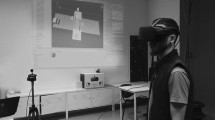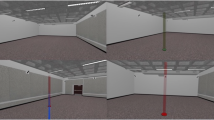Abstract
Auditory cues are integrated with vision and body-based self-motion cues for motion perception, balance, and gait, though limited research has evaluated their effectiveness for navigation. Here, we tested whether an auditory cue co-localized with a visual target could improve spatial updating in a virtual reality homing task. Participants navigated a triangular homing task with and without an easily localizable spatial audio signal co-located with the home location. The main outcome was unsigned angular error, defined as the absolute value of the difference between the participant’s turning response and the correct response towards the home location. Angular error was significantly reduced in the presence of spatial sound compared to a head-fixed identical auditory signal. Participants’ angular error was 22.79° in the presence of spatial audio and 30.09° in its absence. Those with the worst performance in the absence of spatial sound demonstrated the greatest improvement with the added sound cue. These results suggest that auditory cues may benefit navigation, particularly for those who demonstrated the highest level of spatial updating error in the absence of spatial sound.



Similar content being viewed by others
Notes
This paper was the most relevant example of a single localizable cue influencing turning during gait when the study was designed.
ICC was calculated using a null/intercept only model.
Significance values were determined using a likelihood ratio test, all models successfully converged
References
Anderson, P. W., & Zahorik, P. (2014). Auditory/visual distance estimation: Accuracy and variability. Frontiers in Psychology, 5, 1097.
Barhorst-Cates, E. M., Stoker, J., Stefanucci, J. K., & Creem-Regehr, S. H. (2021). Using virtual reality to assess dynamic self-motion and landmark cues for spatial updating in children and adults. Memory & Cognition, 49(3), 572–585.
Bates, D., Mächler, M., Bolker, B., & Walker, S. (2015). Fitting linear mixed-effects models using lme4. Journal of Statistical Software, 67(1), 1–48. https://doi.org/10.18637/jss.v067.i01
Chen, X., McNamara, T. P., Kelly, J. W., & Wolbers, T. (2017). Cue combination in human spatial navigation [Publisher: Elsevier Inc.]. Cognitive Psychology, 95, 105–144. https://doi.org/10.1016/j.cogpsych.2017.04.003
Clemenson, G. D., Maselli, A., Fiannaca, A. J., Miller, A., & Gonzalez-Franco, M. (2021). Rethinking GPS navigation: Creating cognitive maps through auditory clues. Scientific Reports, 11(1), 1–10. https://doi.org/10.1038/s41598-021-87148-4
Faul, F., Erdfelder, E., Lang, A.-G., & Buchner, A. (2007). G*power 3: A flexible statistical power analysis program for the social, behavioral, and biomedical sciences. Behavior Research Methods, 39, 175–191. https://doi.org/10.3758/BF03193146
Grantham, D. W., Hornsby, B. W. Y., & Erpenbeck, E. A. (2003). Auditory spatial resolution in horizontal, vertical, and diagonal planes. The Journal of the Acoustical Society of America, 114(2), 1009–1022. https://doi.org/10.1121/1.1590970
Gröhn, M., Lokki, T., & Takala, T. (2005). Comparison of auditory, visual, and audiovisual navigation in a 3d space. ACM Transactions on Applied Perception (TAP), 2(4), 564–570.
Hamacher, D., Schley, F., Hollander, K., & Zech, A. (2018). Effects of manipulated auditory information on local dynamic gait stability. Human Movement Science, 58(March), 219–223. https://doi.org/10.1016/j.humov.2018.02.010
Hegarty, M., & Waller, D. (2005). Individual differences in spatial abilities. The Cambridge handbook of visuospatial thinking, 121–169.
Kaipust, J. P., McGrath, D., Mukherjee, M., & Stergiou, N. (2013). Gait variability is altered in older adults when listening to auditory stimuli with differing temporal structures. Annals of Biomedical Engineering, 41(8), 1595–1603. https://doi.org/10.1007/s10439-012-0654-9
Karim, A., Rumalla, K., King, L., & Hullar, T. E. (2017). The effect of spatial auditory landmarks on ambulation. Gait and Posture, 60, 171–174. https://doi.org/10.1016/j.gaitpost.2017.12.003
Karimpur, H., & Hamburger, K. (2016). Multimodal integration of spatial information: The influence of object-related factors and self-reported strategies. Frontiers in Psychology, 7, 1443.
Klatzky, R. L., Marston, J. R., Giudice, N. A., Golledge, R. G., & Loomis, J. M. (2006). Cognitive load of navigating without vision when guided by virtual sound versus spatial language. Journal of experimental psychology: Applied, 12(4), 223.
Kolarik, A. J., Moore, B. C., Zahorik, P., Cirstea, S., & Pardhan, S. (2016). Auditory distance perception in humans: A review of cues, development, neuronal bases, and effects of sensory loss. Attention, Perception, & Psychophysics, 78(2), 373–395.
Kuznetsova, A., Brockhoff, P. B., & Christensen, R. H. B. (2017). lmerTest package: Tests in linear mixed effects models. Journal of Statistical Software, 82(13), 1–26. https://doi.org/10.18637/jss.v082.i13
Long, R. G., & Giudice, N. A. (2010). Establishing and maintaining orientation for mobility. In B. Blasch, W. Wiener, & R. Welch (Eds.), Foundations of orientation and mobility (pp. 45–62). New York: American Foundation for the Blind.
Loomis, J. M., Golledge, R. G., & Klatzky, R. L. (1998). Navigation system for the blind: Auditory display modes and guidance. Presence, 7(2), 193–203.
Loomis, J. M., Klatzky, R. L., Philbeck, J. W., & Golledge, R. G. (1998). Assessing auditory distance perception using perceptually directed action. Perception & Psychophysics, 60(6), 966–980.
Loomis, J. M., Lippa, Y., Klatzky, R. L., & Golledge, R. G. (2002). Spatial updating of locations specified by 3-d sound and spatial language. Journal of Experimental Psychology: Learning, Memory, and Cognition, 28(2), 335.
Lüdecke, D., Ben-Shachar, M. S., Patil, I., Waggoner, P., & Makowski, D. (2021). performance: An R package for assessment, comparison and testing of statistical models. Journal of Open Source Software, 6(60), 3139. https://doi.org/10.21105/joss.03139
Maheu, M., Sharp, A., Landry, S. P., & Champoux, F. (2017). Sensory reweighting after loss of auditory cues in healthy adults. Gait and Posture, 53, 151–154. https://doi.org/10.1016/j.gaitpost.2017.01.015
Marme-Karelse, A. M., & Bles, W. (1977). Circular vection and human posture, II. Does the auditory system play a role? Agressologie: revue internationale de physio-biologie et de pharmacologie appliquées aux effets de l’agression, 18(6), 329–33. http://www.ncbi.nlm.nih.gov/pubmed/613848
Newcombe, N. S., Hegarty, M., & Uttal, D. (2023). Building a cognitive science of human variation: Individual differences in spatial navigation.
Padilla, L. M., Creem-Regehr, S. H., Stefanucci, J. K., & Cashdan, E. A. (2017). Sex differences in virtual navigation influenced by scale and navigation experience. Psychonomic Bulletin & Review, 24, 582–590.
R Core Team. (2022). R: A language and environment for statistical computing. R Foundation for Statistical Computing. Vienna, Austria. https://www.R-project.org/
Seiwerth, I., Jonen, J., Rahne, T., Schwesig, R., Lauenroth, A., Hullar, T. E., & Plontke, S. K. (2018). Influence of hearing on vestibulospinal control in healthy subjects. Hno, 66, 49–55. https://doi.org/10.1007/s00106-018-0520-7
Shaw, M., Rights, J. D., Sterba, S. S., & Flake, J. K. (2023). R2mlm: An r package calculating r-squared measures for multilevel models. Behavior Research Methods, 55(4), 1942–1964.
Shayman, C. S., Earhart, G. M., & Hullar, T. E. (2017). Improvements in gait with hearing aids and cochlear implants. Otology & Neurotology, 38(4), 484–486. https://doi.org/10.1097/MAO.0000000000001360
Shayman, C. S., Peterka, R. J., Gallun, F. J., Oh, Y., Chang, N.-Y.N., & Hullar, T. E. (2020). Frequency-dependent integration of auditory and vestibular cues for self-motion perception. Journal of Neurophysiology, 123(3), 936–944. https://doi.org/10.1152/jn.00307.2019
Stevens, M. N., Barbour, D. L., Gronski, M. P., & Hullar, T. E. (2017). Auditory contributions to maintaining balance. Journal of Vestibular Research, 26(5–6), 433–438. https://doi.org/10.3233/VES-160599
Weaver, T. S., Shayman, C. S., & Hullar, T. E. (2017). The Effect of Hearing Aids and Cochlear Implants on Balance During Gait. Otology & Neurotology, 38(9), 1327–1332. https://doi.org/10.1097/MAO.0000000000001551
Werkhoven, P., van Erp, J. B., & Philippi, T. G. (2014). Navigating virtual mazes: The benefits of audiovisual landmarks. Displays, 35(3), 110–117.
Zanchi, S., Cuturi, L. F., Sandini, G., & Gori, M. (2022). Interindividual differences influence multisensory processing during spatial navigation. Journal of Experimental Psychology: Human Perception and Performance, 48(2), 174–189. https://doi.org/10.1037/xhp0000973
Zarei, H., Norasteh, A. A., & King, L. (2022). The effect of auditory cues on static postural control: A systematic review and meta-analysis. Audiology and Neurotology, 27(6), 427–436.
Author information
Authors and Affiliations
Corresponding author
Additional information
Publisher's Note
Springer Nature remains neutral with regard to jurisdictional claims in published maps and institutional affiliations.
This research was supported by the National Institute On Deafness And Other Communication Disorders under Award Number 1F30DC021360-01 (Shayman), and by the American Otological Society in the form of a Fellowship Grant (Shayman). The authors would like to thank Jessica Stoker for her help with data collection and Munzer Abusham for his help with virtual environment development. The data and analysis script for this study are available on Open Science Framework.
Rights and permissions
Springer Nature or its licensor (e.g. a society or other partner) holds exclusive rights to this article under a publishing agreement with the author(s) or other rightsholder(s); author self-archiving of the accepted manuscript version of this article is solely governed by the terms of such publishing agreement and applicable law.
About this article
Cite this article
Shayman, C.S., Whitaker, M.M., Barhorst-Cates, E. et al. The addition of a spatial auditory cue improves spatial updating in a virtual reality navigation task. Atten Percept Psychophys (2024). https://doi.org/10.3758/s13414-024-02890-x
Accepted:
Published:
DOI: https://doi.org/10.3758/s13414-024-02890-x




